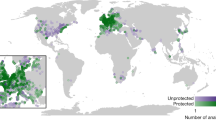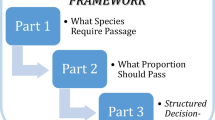Abstract
The ecological character of seasonal marshes is determined in large part by the pattern of water level fluctuation. As a result, the ecological health of a wetland reserve can be controlled by hydrologic regulation external to its boundaries. As an example, the Everglades marsh of Everglades National Park in Florida, USA, has been severely effected by management of the inflow of surface water. The Everglades occupies most of the interior of southern Florida, but only the lower 6% of the original marsh is contained in Everglades National Park. Shallow surface water reservoirs north of the park enclose 3600 km2 of Everglades. Their levee system confines surface water flow into the park to several structures. Historically this water flowed across the entire core of the natural drainage. Flows into the park have been on a congressionally mandated schedule of minimum deliveries that is supplemented by additional water released into the park in amounts determined solely by upstream water management needs. My research, aimed at evaluating the effects of water conditions, has shown that this regulatory system has adversely affected reproductive success, community structure, and population sizes of sensitive species whose population stability is tied to natural water level fluctuations. These adverse effects were caused by water levels that for over a decade have been maintained at unseasonably high levels. Mathematically deterministic models of water level effects can provide management options based on biologial criteria. Park managers must incorporate understanding gained from such models into internal management decisions. Modifications of water control structures and alternative policies for managing the distribution and amount of surface water flow into the park appear attainable, can improve biological conditions in the park, and need not be adverse to neighboring external interests. Thus far biological changes are severe, and to a large extent irreversible. Ecologically sensitive management of an external threat under constraints imposed by history and setting can better maintain some semblance of ecological processes in the Everglades. If management decisions do not reflect such understanding of ecological processes, further ecological deterioration will result.
Similar content being viewed by others
Literature cited
Browder, J. A. 1985. Relationship between pink shrimp production on the Tortugas grounds and water flow patterns in the Florida Everglades.Bulletin of Marine Science 37:839–856.
Costello, T. J., and D. M. Allen. 1966. Migrations and geographic distribution of pink shrimp,Penaeus duorarum, on the Sanibel and Tortugas grounds, Florida.Fisheries Bulletin 65:449–459.
Davis, G. 1980. Changes in the Everglades National Park red drum and spotted seatrout fisheries 1958–1978: fishing pressure, environmental stress, or natural cycles? Pages 81–87in R. O. Williams (ed.), Proceedings of Red Drum and Seatrout Colloquium.
Douglas, M. S. 1947. The Everglades: river of grass. Rinehart and Company, New York.
Flora, M. D., and P. C. Rosendahl. 1982. The response of specific conductance to environmental conditions in the Everglades National Park, Florida.Water, Air, and Soil Pollution 17:51–59.
Johnson, R. R., and S. W. Carothers. 1987. External threats: the dilemma of resource management on the Colorado River in Grand Canyon National Park, USA.Environmental Management 11:99–107 [this issue].
Klein, J., J. T. Armbruster, B. F. McPherson, and H.J. Freiberger. 1975. Water and the south Florida environment. US Geological Survey, Water-resources Investigation 24-75, Tallahassee, Florida.
Kushlan, J. A. 1974. Observations on the role of the American alligator (Alligator mississippiensis) in the southern Florida wetlands.Copeia 1974:993–996.
Kushlan, J. A. 1976. Environmental stability and fish community diversity.Ecology 57:821–825.
Kushlan, J. A. 1979. Design and management of continental wildlife reserves: lessons from the Everglades.Biological Conservation 15:281–290.
Kushlan, J. A. 1986. The Everglades: management of cumulative ecosystem degradation.In Cumulative impacts in Florida wetlands. Mote Marine Laboratory, Sarasota, Florida (in press.)
Kushlan, J. A., and P. C. Frohring. 1986. The history of the southern Florida wood stork population.Wilson Bulletin 93:368–386.
Kushlan, J. A., and T. Jacobsen. 1986. Predictability in a fluctuating environment: the reproductive success of Everglades alligators. (In preparation.)
Kushlan, J. A., J. C. Ogden, and A. L. Higer. 1975. Relation of water level and fish availability to wood stork reproduction in southern Everglades, Florida. US Geological Survey Report 75-434, Tallahassee, Florida.
Leach, S. D., H. Klein, and E. R. Hampton. 1972. Hydrologic effects of water control and management of southeastern Florida. Florida Bureau of Geology, Report of Investigations 60.
Lugo, A. E., S. C. Snedaker, S. Bayley, and H. T. Odum. 1971. Models for planning and research for the south Florida environmental study. University of Florida, Gainesville, Florida.
Odum, H. T., and M. T. Brown (eds.). 1976. Carrying capacity for man and nature in South Florida. Center for wetlands, University of Florida, Gainesville, Florida.
Ogden, J. C., J. A. Kushlan, and J. T. Tilmant. 1976. Prey selectivity by the wood stork.Condor 78:324–330.
Ward, F. 1972. The imperiled Everglades.National Geographic 141:1–27.
Author information
Authors and Affiliations
Rights and permissions
About this article
Cite this article
Kushlan, J.A. External threats and internal management: the hydrologic regulation of the Everglades, Florida, USA. Environmental Management 11, 109–119 (1987). https://doi.org/10.1007/BF01867186
Issue Date:
DOI: https://doi.org/10.1007/BF01867186




